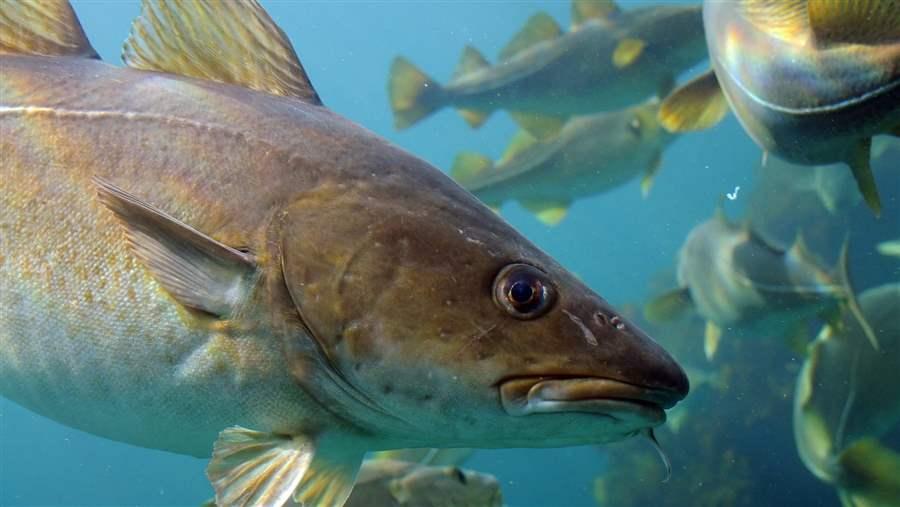With New Fish Rule, NOAA Lets the Big One Get Away
Failure to embrace big-picture fisheries management could hurt fish, fishermen, and businesses

In New England, populations of cod, like those seen here in the northeastern Atlantic Ocean, have plummeted due to severe overfishing and environmental factors, such as warming waters. Fishery managers could better help cod and other species by taking a big-picture approach to governing ocean resources.
© Joachim S. Mueller
This piece was previously published in The Huffington Post.
When you take your car in for a tuneup, do you have only the spark plugs examined?
Of course not. You ask the mechanic to look at the whole vehicle—the engine, fluids, fuel system, and the many other parts that must work together for your car to run smoothly.
That same comprehensive approach can help spot and resolve problems in other complex systems. In our oceans, for example, it could translate into a huge benefit for fish and the many people who rely on sustainable marine life, including fishermen, chefs, and coastal business owners.
This strategy, called ecosystem-based fisheries management (EBFM), means that before managers set fishing rules for a population, they should factor in where those fish live, what they eat, what eats them, what other roles they perform in the oceans, what threats they face from a changing marine environment, and how fishing affects ecosystems. Fisheries scientists say EBFM will help dwindling species recover and boost healthy populations—achievements that can bring economic benefits to fishing businesses and coastal economies for years to come.
In October the National Oceanic and Atmospheric Administration (NOAA), which oversees our nation’s fisheries, passed up a chance to take a major step toward EBFM. In revising a set of guidelines called National Standard 1—a critical reference for fisheries managers as they implement the nation’s primary fishing law, the Magnuson-Stevens Fishery Conservation and Management Act—NOAA’s Fisheries Service failed to require that managers consider the broader marine ecosystem when setting catch limits and other fisheries measures.
This is surprising given that NOAA has successfully used National Standard 1 in recent years to direct federal fisheries managers to prevent overfishing and rebuild depleted fish populations, and has shown a commitment to EBFM by supporting and publishing scientific studies about it, promoting it, weighing how to implement the concept, and adopting an overarching national policy about it.
Just last month, a panel of natural and social scientists convened by the Lenfest Ocean Program and chaired by leading fisheries scientists from the University of Washington, Seattle released a report detailing how to make EBFM work through a comprehensive planning process.
But when it came time to put teeth into that commitment through revision of National Standard 1, NOAA fell short, letting down the tens of thousands of people who submitted public comments supporting inclusion of the method in the guidelines.
The agency says that a few provisions in its revised guidelines advance EBFM. But those measures could actually increase overfishing of struggling populations by allowing managers to lump less-populous fish stocks together with healthier populations when determining the long-term catch that a fishery can sustain—a key measurement used to prevent overfishing when setting quotas. NOAA hasn’t adequately advised managers on how to use the technique and prevent overfishing of vulnerable individual stocks while grouping fish populations, or how to deal with the uncertainties of applying it, and in fact is touting this very risky practice as the guidelines’ most notable step toward EBFM.
The new guidelines allow managers to measure progress not by how well their plans are working to restore depleted populations, but simply by determining how well managers are following their plans. And the revised standards contain troubling language on how to determine whether a fish species is in need of conservation and management, and they allow managers to delay lowering catch limits even when new scientific information shows a need to do so.
Overall, the guidelines shortchange fish and the people whose livelihoods depend on healthy fish populations. Hopefully fisheries managers will see the guidelines as a minimum standard and choose to go further to protect our marine resources, now and for future generations.
Lee Crockett leads The Pew Charitable Trusts’ efforts to establish policies to end overfishing and promote EBFM in the United States under the authority of the Magnuson-Stevens Act.











